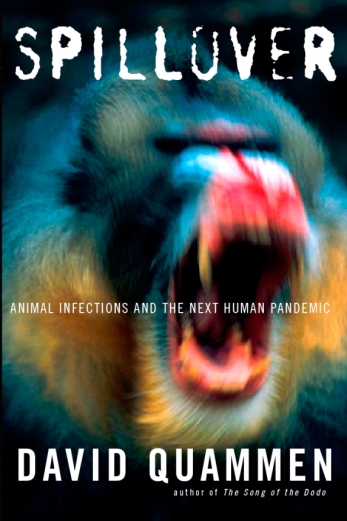The Bodley Head (2012), 592 pages
Spillover: Animal Infections and the Next Human Pandemic is an astonishing book. If you’ve ever wondered how viruses such as Ebola or bird flu jumped from animals to humans then this is the book for you. As Quammen explains, “When a pathogen leaps from some nonhuman animal into a person, and succeeds in establishing itself as an infectious presence, sometimes causing illness or death, the result is zoonosis.” (p.20) There is a long list of zoonotic diseases including Ebola, bubonic plague, HIV/AIDS, Spanish flu, bovine tuberculosis, Lyme disease, West Nile virus, rabies, anthrax, Lassa fever, and Marburg virus. Diseases which only infect humans (such as smallpox or polio) are easier to contain and eradicate as you only have to eradicate it in one species. It is incredibly difficult to eradicate a disease such as Ebola which can pass between bats, primates, and humans. How can you vaccinate or cull every infected bat population in high trees and deep caves? Quammen suggests that the seeming increase in zoonotic diseases in recent decades has a number of causes including better detection and communication (in the past zoonotic diseases could have been mistaken for something else or hidden in a remote village), an increasing human population (which increases the odds of infection), and, perhaps most importantly, ecological destruction which has unknown consequences.
The key to reducing the potentially devastating effects of zoonotic diseases lies with medical science, education, and better care for the delicate ecosystems that operate in the world. The effects of AIDS has slowly been reduced through antiretroviral drugs and educating people how to reduce their risk of infection. Educating people in Ebola risk areas about the dangers of eating bushmeat (such as primates (Ebola has also had a devastating impact on gorillas) or bats), explaining why traditional burial rites may need to be modified, and explaining the cause of the Ebola virus to an, at times, extremely superstitious population is a good start. Superstitious beliefs in sorcery or evil spirits have a logic of their own but often leave the believer poorly equipped to reduce their risk of infection (although some groups such as the Acholi of Uganda successfully modified their beliefs to reduce the impact of outbreaks of disease (p.88-89).
Spillover also covers AIDS in some depth. Groundbreaking research has even identified the time and location of the first transfer of HIV to a human, “AIDS began with a spillover from one chimp to one human, in southwestern Cameroon, no later than 1908 (give or take a margin of error) and grew slowly but inexorably from there.” (p.427). As with Ebola, the eating of bushmeat seems to have been a factor. The Wikipedia page on the history of HIV/AIDS gives a slightly different account. If there is one unsatisfactory part of Spillover it is a Heart of Darkness style imagining of the first HIV victim. This section, featuring a murderous African man, sits uneasily in a scientific book. Conjecture about the probable spread of HIV/AIDS from a rural setting to an African city (and subsequent movement by boat to Europe and the USA – although Quammen makes a convincing case that the major US AIDS outbreak was caused by imported Haitian blood plasma in the 1970s) is fine. Imagining the type of dress the woman this African (named Voyager) sleeps with is somewhat ludicrous. Spillover is a great book but this section should have been left on the editor’s floor.
Quammen covers a huge amount of ground in Spillover from Ebola, to SARS, to AIDS (and many more too) but as zoonotic diseases transfer from animals to humans in a similar way he is able to paint a coherent picture of the threat posed to humanity by these slippery diseases and highlight how their effects can be minimised. Spillover (despite the cover of an irate baboon) is not sensationalist and carefully explains the causes of zoonotic diseases and why, if we heed the experts in the field, humanity is not doomed by these cruel diseases.
9/10

